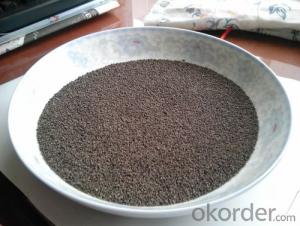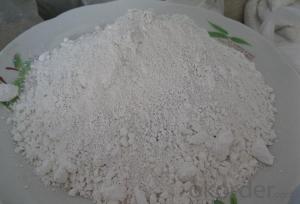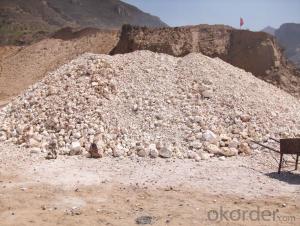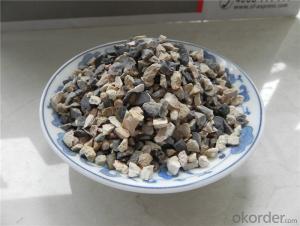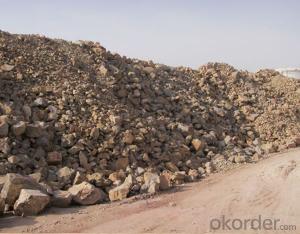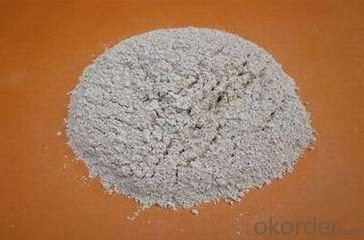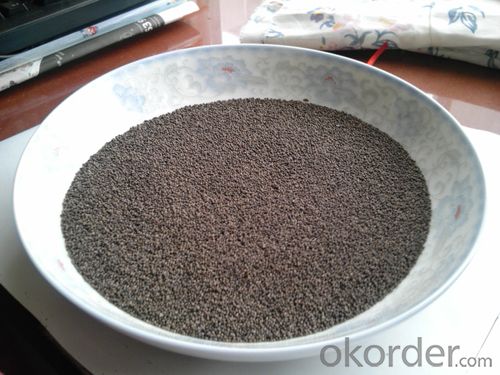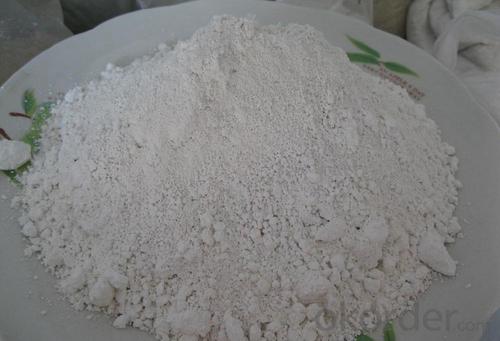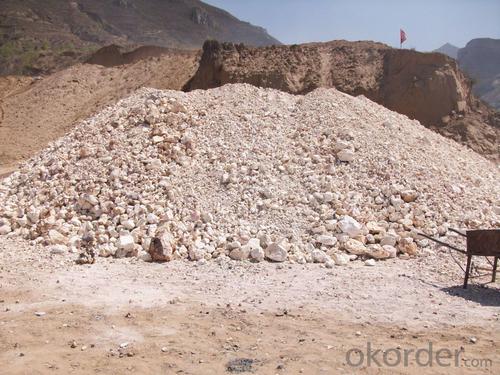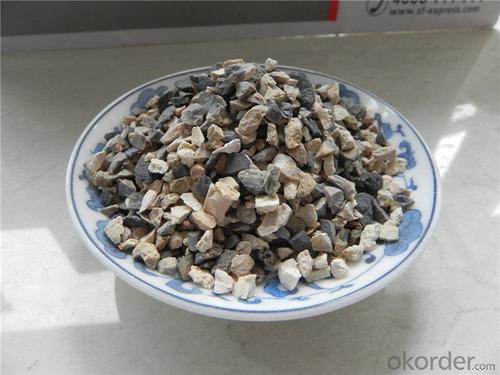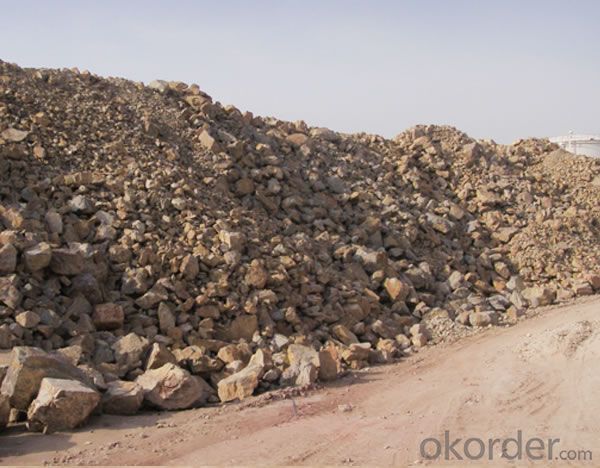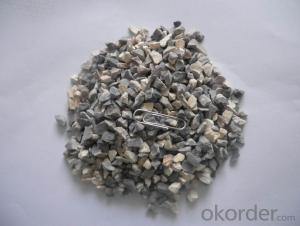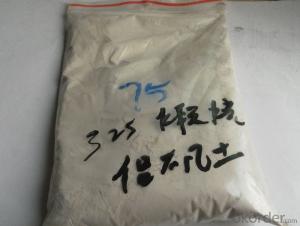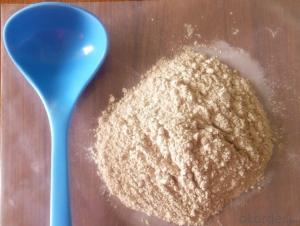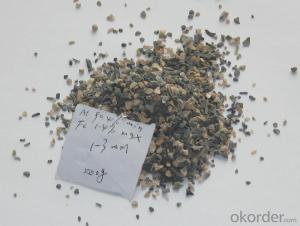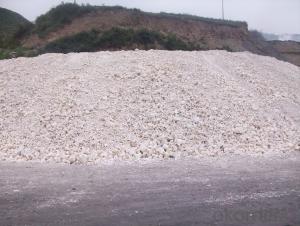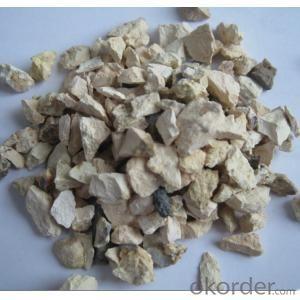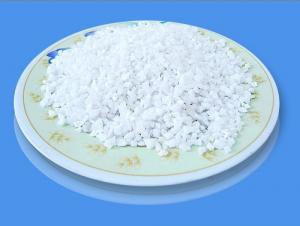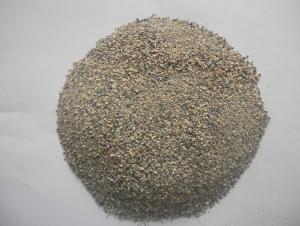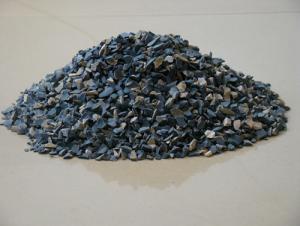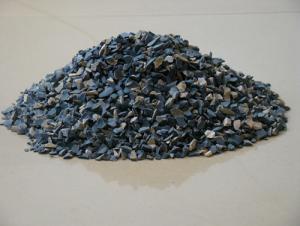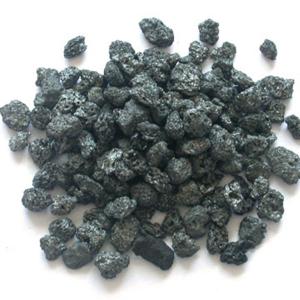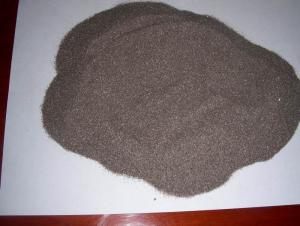Raw Materials for Refractory:82% Rotary/Shaft/Round Kiln Alumina Calcined Bauxite
- Loading Port:
- Tianjin
- Payment Terms:
- TT OR LC
- Min Order Qty:
- 25 m.t.
- Supply Capability:
- 3000 m.t./month
OKorder Service Pledge
OKorder Financial Service
You Might Also Like
82% Rotary/ Shaft/ Round Kiln Alumina Calcined Bauxite Raw Material for Refractory
Specifications
1 Al2O3:>=85%
2 Fe2O3:<=2.0%
3.Bulk Density:>=3.0g/cm3
4. Origin: SHANXI ,CHINA
5. refractory/welding industry
Item | AL2O3 | FE2O3 | TIO2 | K2O+Na2O | CaO+MgO | Bulk density |
GAL75 | ≥75 | ≤2.5 | ≤4.0 | ≤0.3 | ≤0.5 | ≥2.7 |
GAL80 | ≥80 | ≤2.5 | ≤4.0 | ≤0.3 | ≤0.5 | ≥2.8 |
GAL85 | ≥85 | ≤2 | ≤4.0 | ≤0.3 | ≤0.5 | ≥3.0 |
GAL86 | ≥86 | ≤2 | ≤4.0 | ≤0.3 | ≤0.5 | ≥3.1 |
GAL87 | ≥87 | ≤2 | ≤4.0 | ≤0.3 | ≤0.5 | ≥3.2 |
GAL88 | ≥88 | ≤1.8 | ≤4.0 | ≤0.25 | ≤0.5 | ≥3.25 |
GAL90 | ≥90 | ≤1.8 | ≤4.0 | ≤0.25 | ≤0.5 | ≥3.3 |
Size:
Lumps /Grains:0-1mm,1-3mm,3-5mm,5-8mm /Powders:100mesh, 200mesh,325mesh
Product Description:
Bauxite, alumina or bauxite miner , main ingredients are aluminum oxide, hydrate alumina containing impurities,
is an earthy mineral.White or grey, brown yellow or light red by iron.From 4 to 3.9 g/cm3 density, hardness, 1 ~ 3, opaque, very brittle.
Very difficult to melt.Insoluble in water, soluble in sulfuric acid, sodium hydroxide solution.Mainly used for aluminium, refractory material.
Calcined Bauxite Grade:
Shaft Kiln Bauxite
Rotarty Kiln Bauxite
Round Kiln Bauxite
Packaging & Delivery
Packaging Details: In bulk or in 1-1.25mr bag
Product Pictures:
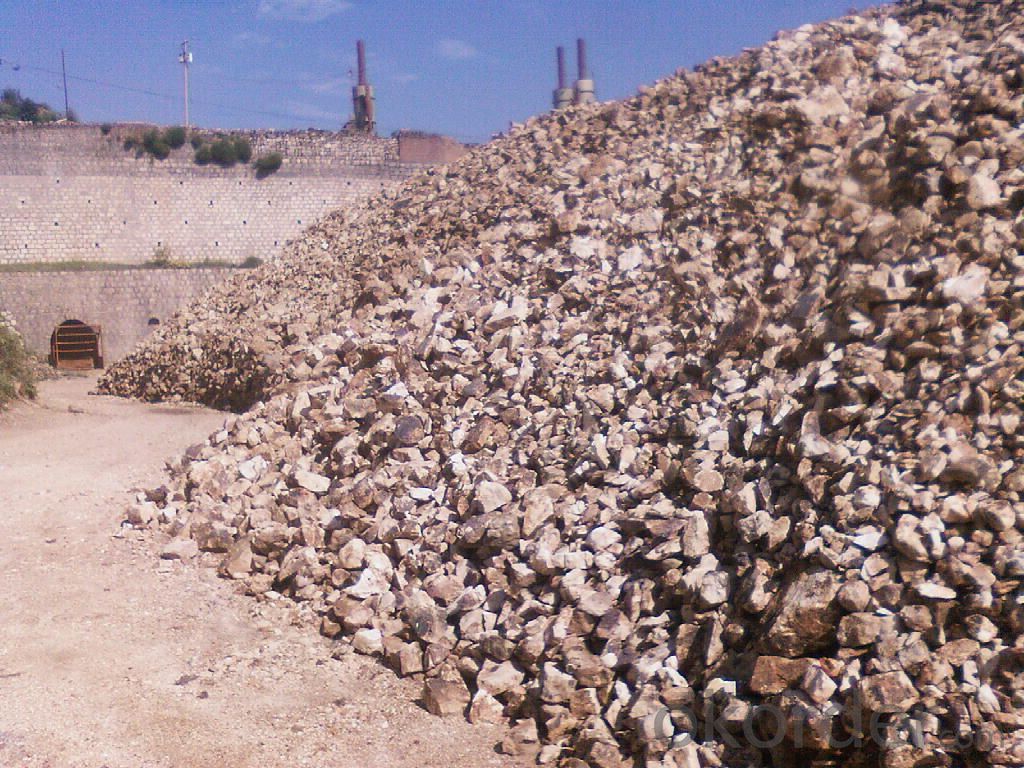
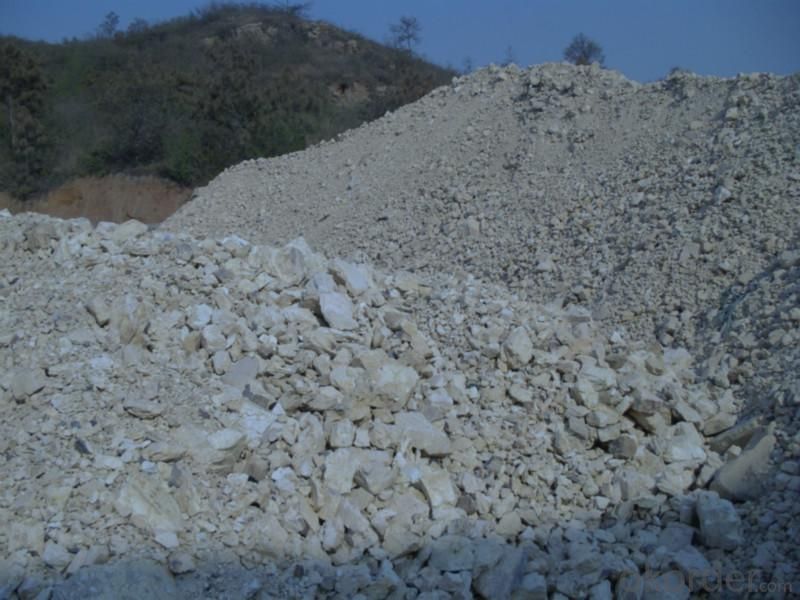
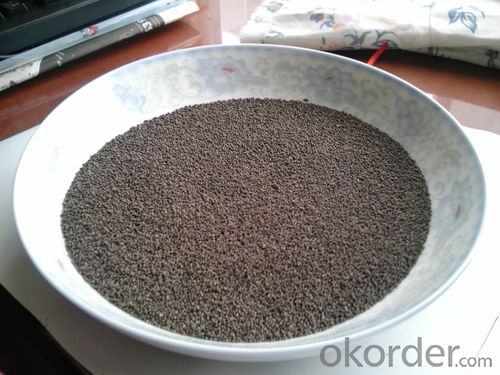
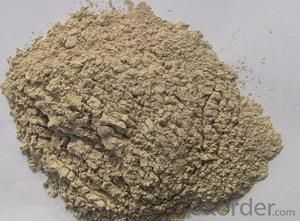
Our Service:
1. Your inquiry related to our products or prices will be replied in 24hours.
2. Manufacturer with large capacity, ensure the fast production cycle after confirmed the order.
3. Our professional technicians will answer your entire enquiry in patient.
4. To meet the refractory solutions, we can serve as your instructions.
5. Protection of sales area and private information for our entire customer.
If you’ve kind enquiries, please don’t hesitate to let us know. ^_^
- Q: What kinds of fireproof and fire retardant materials are there?
- fireproof materials are mainly non-combustible A material and flame retardant B1materials. Class A non-combustible material: Granite, marble, terrazzo, cement products, concrete products, plasterboard, lime products, clay, glass, tiles, mosaics, steel, aluminum, copper alloy; B1 grade flame retardant materials: Ceiling materials gypsum board, gypsum fiber boards, cement particle board, mineral wool acoustic panels, glass wool decorative acoustic board, perlite decorative acoustic board, flame retardant plywood, medium density fiberboard flame, rock wool decorative panels, retardant wood, aluminum composites, flame retardant phenolic plywood, aluminum foil, glass fiber reinforced plastic composite materials; wall materials gypsum board, gypsum fiber boards, cement particle board, mineral wool board, glass wool board, perlite board, flame retardant plywood, retardant MDF, fireproof plastic decorative plates, flame-sided particleboard, colorful paint, flame retardant wallpaper, wall covering flame retardant, flame imitation granite decorative plates, magnesium oxychloride cement prefabricated wall panels, flame retardant glass fiber reinforced plastic plate, PVC plastic sheeting, high-strength lightweight composite panels, fire-retardant molded wood composite board, color retardant plywood, fiberglass and other flame retardant.
- Q: Does anyone know the refractory temperature of fire-resistant glass?
- Ordinary glass will be completely liquefied in the furnace of about 1100 degrees for half an hour and will not deform below 600 degrees. toughened glass fire-resistant glass is the product of ordinary glass after being processed Glass will mainly burst after encountering fire. When unevenly heated or encountering sudden drastic changes in temperature, ordinary glass will burst if the sharp temperature difference is over 70-120 degrees and toughened glass will burst at 200 degrees. It is not yet clear of the bursting temperature for the refractory glass. If the overall glass is not heated evenly, it will have no significant change below 600 degrees, and it will deform with the increase of temperature until melting. The fire-resistant time of the glass you said is the time to heat the glass into the extreme temperature differences it can endure, which should not be more than 10 minutes
- Q: How many kinds of fireproof materials are there in the market?
- Inorganic insulation materials basically can achieve the goal, such as glass wool, rock wool, and foam glass. The phenolic foam in the organic foam material is special. Phenolic foam is not only good at insulation, but also good at compounding with steel and other materials to achieve A-level performance, and the A-level insulation materials are: rock(ore) wool, foam glass and inorganic thermal insulation mortar. Insulation materials with B1 combustibility mainly are: Phenolics, polystyrene granules, etc. The insulation materials of fire barrier zone can use such A-level materials as rock (ore) wool, foam glass, and inorganic thermal insulation mortar, etc.
- Q: What kind of fireproof material is used for steel structure?
- Fireproof material means the coating is with thickness 3 mm (including 3 mm) or less, good decorative effect, capable of expanding foam, fire endurance of generally within 2 h of steel structure fire at high temperatures. fire-resistant coating for steel structure is generally solvent-based systems, with strong bond strength, water resistance, weatherproof, good flowing property, decorative; it slowly expanded at high temperature to a dense layer of fire insulation, which has a strong refractory shock, delaying the rise of steel, protecting steel components. ultra-thin?intumescent?fireproof coatings?for steel?structure can be used by spraying, brushing or rolling, generally using construction steel with fire endurance within 2 h. new type of ultra-thin fireproof coatings for steel structure has a fire endurance of 2 hours or more, mainly using binding agents of polymethacrylate or epoxy resin and amino?resin and chlorinated?paraffin, which are of special structure, added with fire retardant system such as high degrees of polymerization, phosphoric?acid, dipentaerythritol, adding titanium dioxide, wollastonite and other inorganic refractory materials, solvent oil 200 # solvent composite. All kinds of light steel structure, grid and other use of this type of fire-resistant coating conduct fire protection. As such the fire retardant paint coating is ultra-thin, greatly reducing the amount of thin steel structure fire retardant coating, thereby decreasing the total cost of the project. The steel is protected and the fire is prevented.
- Q: Which are fire proofing thermal insulation materials?
- Which are fire proofing thermal insulation materials? Which fire proofing thermal insulation materials are commonly seen?
- Q: Who knows about the grade C fireproof door materials?
- There are no differences in the interior materials of the grade A , B and C fire doors, they all use fire?rock?wool?boards. The only difference is the thickness of built-in fire rock wool boards. The rock wool boards' thickness of grade A fire doors is 52 mm, that of grade B is 46mm, and that of grade C is 40 mm.
- Q: How should fireproof building materials be ranked?
- According to our national standard GB8624-97, the combustion performance of building materials are divided into the following levels: A class: Incombustible building materials: the material is almost incombustible. B1 class: Flame-retardant building materials: they are better in fire retardation. It is non-combustible when meeting open fire in the air or under high temperature, and it is difficult for the fire to spread quickly. Besides, when the fire source is removed, combustion stops immediately. B2 class: Combustible building material: It has certain fire retardation. In case of open fire in the air or at high temperature, it will immediately burst into flames, and easily lead to the spread of fire, such as the spread to wooden pillars, timber roof truss, timber beams, wood stairs, etc. B3 class: Flammable building material: It has no fire retardant effect at all, but is highly flammable with high fire risk. Hope my answer can be accepted.
- Q: What is the difference between the fire?rating and the fire resistant level of the fire-fighting equipment?
- Hello there. Fire rating and fire-fighting rating are the misnomer to the building fire resistant level. The building fire risk is measured by fire resistant level. The article 3.2.1 and 5.1.7 of "Architectural design code for fire protection" have made provision respectively on the fire resistant level of plant (the storeroom) and civil construction. Article 3.0.2 of "Code for fire protection design of tall buildings" has made provisions on the fire resistant level of tall buildings. As for the warehouse building "category malonate", it refers to one of the fire risk of goods storage, which is divided into A, B, C, D, E, and each category is refined depending on the nature of different substances. "Malonate class" specified in article 3.1.3 of "building design for fire protection" refers to the flammable solid.
- Q: Can anyone tell me what is a high alumina refractory?
- High alumina refractories: High-alumina refractory products have high refractoriness, compressive strength and refractoriness under load, which are used for building the high-temperature parts of various large blast furnaces, such steelmaking furnace, airheater, electric furnace, rotary?kiln and other thermal equipment.
- Q: What are grades of refractory materials?
- Refractories have lots of varieties which all have different purposes. It is necessary to classify refractories scientifically in order to scientifically study, choose and manage them. Classification methods of refractories include chemical properties classification, chemical composition of mineral classification, manufacturing technique classification, morphology of the material classification. 1 divided according to the level of refractoriness: ordinary refractory materials: 1580 ℃ - 1770 ℃, advanced refractories: 1770 ℃ - 2000 ℃ and super refractories: above 2000 ℃ 2, divided in accordance with shapes and sizes : Standard ones: 230mm × 113mm × 65mm, no more than four ruler, (ratio) Max: Min < 4: 1; Shaped ones: no more than two-entrant, (ratio) Max: Min < 6: 1 or having a acute angle of 50 - 70 °; The specific type :( ratio) Max: Min < 8: 1 or having no more than 4-entrants or having an acute angle of 30 - 50 °; and Special products: crucible, containers and tubes. 3, divided according to the method of manufacturing: burned products, non-burned products and unshaped refractories 4. divided according to the chemical properties: acidic refractory materials, neutral refractory materials and basic refractory materials.
Send your message to us
Raw Materials for Refractory:82% Rotary/Shaft/Round Kiln Alumina Calcined Bauxite
- Loading Port:
- Tianjin
- Payment Terms:
- TT OR LC
- Min Order Qty:
- 25 m.t.
- Supply Capability:
- 3000 m.t./month
OKorder Service Pledge
OKorder Financial Service
Similar products
Hot products
Hot Searches
Related keywords

